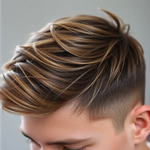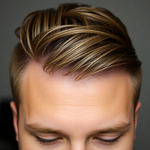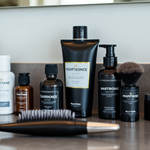
Fade-Friendly Wardrobe: How Semi‑Permanent Hair Color Lets a Small Sustainable Men's Capsule Wardrobe Age Gracefully
10 September 2025
Share
Hook: Solve the ‘worn-out’ look without buying new clothes
Struggling to keep a lean, sustainable wardrobe looking sharp as your hair tone shifts? Fade-Friendly Wardrobe: How Semi‑Permanent Hair Color Lets a Small Sustainable Men's Capsule Wardrobe Age Gracefully is your playbook for extending the life, cohesion, and confidence of a small collection of garments. Use simple color maintenance and smart styling to avoid impulse replacements, save money, and reduce waste.
Why this matters: the wardrobe, the waste, and the image
Capsule wardrobes are built on the idea that fewer, better pieces serve most of your life. But when hair changes—fades from sun, softens with gray, or shifts after dye—those carefully chosen outfits can suddenly look mismatched. Instead of tossing or replacing items, semi-permanent hair color and intentional styling let your look age gracefully. That’s good for your style, your wallet, and the planet.
What semi-permanent hair color actually does
- Deposits pigment on the hair shaft without penetrating the cortex, so it fades gradually.
- Requires no developer or aggressive bleaching for subtle tone shifts.
- Is ideal for maintenance—touch-ups every 4–8 weeks often suffice.
Fade-Friendly Wardrobe: How Semi‑Permanent Hair Color Lets a Small Sustainable Men's Capsule Wardrobe Age Gracefully
Picture this: you built a nine-piece capsule—navy blazer, white tee, charcoal knit, olive chinos, tan boots, and a couple of shirts. Two months later, sun and stress have softened your hair and the contrast with your charcoal knit looks off. Instead of buying a replacement sweater, a semi-permanent color refresh restores the balance in minutes. That harmony keeps your capsule working through seasons and personal changes.
How this approach helps different types of men
- Young professionals: Maintain a consistent, polished image for interviews and meetings with minimal effort.
- Budget-conscious shoppers: Fewer garment replacements mean big savings over time.
- Eco-minded buyers: Less textile waste and fewer salon visits lower your environmental footprint.
- Style experimenters: Change tone and vibe without long-term commitment.
7-step plan to build a truly fade-friendly capsule
- Audit current pieces: Lay out everything you wear near the face—shirts, sweaters, jackets—and note colors that read well with your current hair tone.
- Pick base neutrals + 1 accent: Navy, charcoal, olive, and tan are safe bets. Add one accent color that flatters your skin undertone and hair tone.
- Choose texture over shine: Textured knits and woven shirts hide subtle contrast changes better than glossy fabrics.
- Prioritize natural fibers: Organic cotton, linen blends, and recycled wool age in a visually pleasing way and are often repairable.
- Set a color-maintenance cadence: Check hair tone every 4–8 weeks and use semi-permanent color or color-depositing conditioner as needed.
- Layer strategically: Use collars, scarves, and jackets to buffer the face-to-fabric transition as hair tone shifts.
- Document outfits that work: Keep a simple photo diary to remember combinations that remain harmonious across hair changes.
Grooming and care routines that keep both hair and clothes looking great
- Wash hair less often—2–3 times per week if possible—to slow fade and preserve natural oils.
- Use sulfate-free shampoo and a color-safe conditioner; add a color-depositing conditioner mid-cycle if you need a tone top-up.
- Rinse with cool or lukewarm water to reduce pigment loss and avoid heat damage.
- Protect hair from sun and chlorine—wear a cap or use a UV-protectant spray when outdoors or swimming.
- Look after garments: air-dry when possible, use gentle cycles, and spot-treat stains to avoid unnecessary replacement.
Styling tricks to hide color drift
- Emphasize patterns and texture near the face (striped shirts, ribbed knits) to distract from small hair-to-fabric mismatches.
- Keep a lightweight scarf or open collar for quick contrast adjustments on the go.
- Match accessory tones—watch metal, belt buckle, eyewear—to your hair undertone (warm vs cool) to create visual unity.
- When in doubt, pull a neutral layer over the outfit for instant cohesion.
How to pick the right semi-permanent shade
Choosing the correct tone is half the battle. Aim for subtlety: a shade that complements your natural undertone rather than masking it. If your hair is darkening or showing early gray, opt for a soft, natural shade one level lighter or darker than your base. Always strand-test first. If you want a deeper dive on hair dye safety and considerations, reference this WebMD overview on hair dye safety at: https://www.webmd.com/beauty/hair-dye-safety.
Products and picks: what to buy and what to skip
- Buy: color-depositing conditioners, sulfate-free shampoos, UV-protectant sprays, and a gentle clarifying shampoo for monthly resets.
- Skip: permanent home dyes with developers unless you want a full commitment; cheap hair color that contains harsh ammonia or excessive peroxide.
- Grooming product tip: Menll.com’s grooming and basics collection includes low-impact essentials that pair well with a minimalist wardrobe—clean, durable, and built for everyday wear.
Care schedule: a practical 12-month plan
- Months 1–3: Build and refine your capsule. Note which pieces read best with current hair tone.
- Months 4–5: Expect minor fading; use a color-depositing conditioner once every 1–2 weeks as needed.
- Months 6–8: Re-assess layering and accessories for mid-year changes (sun exposure, vacations).
- Months 9–12: Consider a semi-permanent salon touch-up if tone drift is noticeable; otherwise continue with at-home maintenance and seasonal swaps.
Cost and sustainability math
Swapping an ill-timed garment for a semi-permanent color touch-up is often cheaper and greener. Example: a mid-range sweater replacement might cost $80–150, while a salon semi-permanent refresh or color-depositing product runs $15–60 depending on frequency. Beyond cost, fewer buys mean less textile waste and lower lifecycle emissions—small choices that add up.
Real-life scenarios: two stories that show the approach in action
- The early-career analyst: Mateo, 26, built a 12-piece capsule for office and weekend. After months of commuting, his hair softened and his navy blazer read too stark. A single semi-permanent tone boost and a switch to textured shirts kept the blazer in rotation and saved Mateo from buying three new shirts.
- The creative freelancer: Aaron, 34, loves experimenting with hair but dislikes the commitment. He uses semi-permanent color for subtle warmth when needed and leans on olive and tan garments that hide small contrasts, extending each piece’s lifespan.
Common questions answered
- How long does semi-permanent color last? Typically 4–8 weeks depending on wash frequency, water hardness, and UV exposure.
- Will it damage my hair? Less than permanent dye—no developer—but choose ammonia-free formulas and follow conditioning steps.
- Can I still keep a beach lifestyle? Yes—protect hair with leave-in conditioners and limit pool chlorine exposure after coloring.
Where to buy and what to look for
Look for eco-conscious brands with transparent ingredient lists and color-depositing options. For wardrobe staples that pair well with this strategy, Menll.com’s EcoSneak Casual Shoes and outerwear are durable, sustainable, and designed to age well. Check Menll.com’s outerwear collection for pieces that work with fluctuating hair tones: https://menll.com/collections/outerwear.
Meta suggestions for publishing
Meta title (50–60 chars): Fade-Friendly Wardrobe: Semi‑Permanent Color Tips
Meta description (150–160 chars): Learn how semi‑permanent hair color keeps a small sustainable men's capsule wardrobe cohesive and fresh—practical tips, routines, and product picks.
Key phrase placement and SEO notes
Primary keyword used in title and early in the intro: Fade-Friendly Wardrobe: How Semi‑Permanent Hair Color Lets a Small Sustainable Men's Capsule Wardrobe Age Gracefully. Use the same phrase in an H2 and naturally 2–3 times through the body to satisfy on-page relevance while keeping copy readable. Related secondary keywords to include across headings and alt text: 'semi-permanent hair dye', 'men's capsule wardrobe', 'sustainable men's capsule wardrobe'.
Final checklist before you try this
- Decide on your base palette and one accent color that flatters your skin and hair undertones.
- Buy a color-depositing conditioner or schedule a low-impact salon touch-up every 4–8 weeks.
- Document 8–12 outfit combos that work with current hair tone and rotate them weekly.
- Invest in 1–2 durable Menll.com staples that anchor your capsule and tolerate daily wear.
One final thought
Small choices—an intentional shade touch-up, a textured knit, a well-placed scarf—let you keep fewer clothes and still look like a million. Fade-friendly strategies are less about masking change and more about designing a wardrobe that moves with you.
Call to action
Which piece in your capsule would you most like to keep longer: the favorite knit, your go-to jacket, or that versatile tee? Tell us below, or browse Menll.com for sustainable basics that wear well over time.
Vorheriger Beitrag

Semi-Permanent Hair Color: A Low-Waste Strategy for a Seasonless Men's Capsule Wardrobe
Aktualisiert am 11 September 2025
Nächster Beitrag

Semi-Permanent Hair Color: Low-Waste Hack to Expand Your Men's Capsule Wardrobe
Aktualisiert am 09 September 2025





